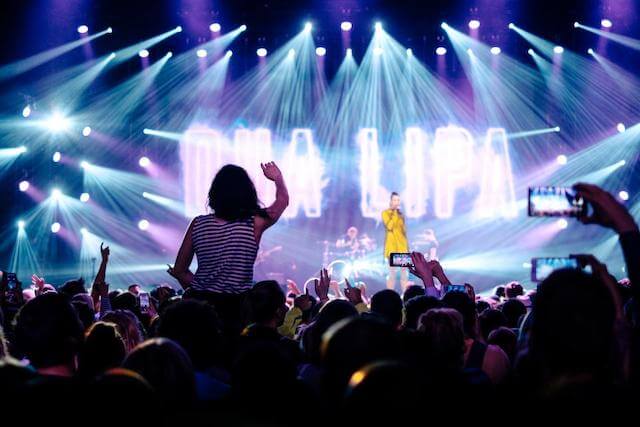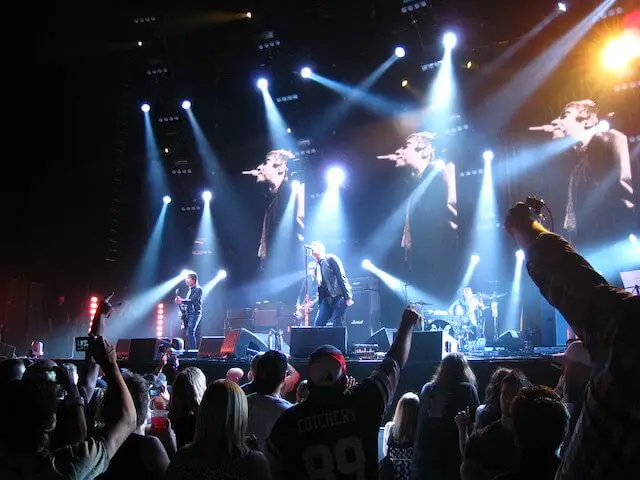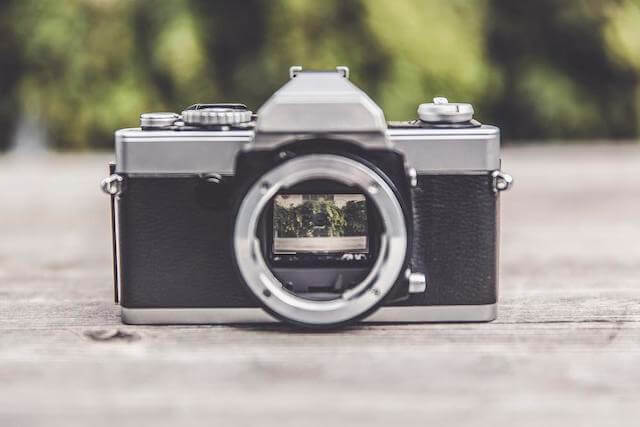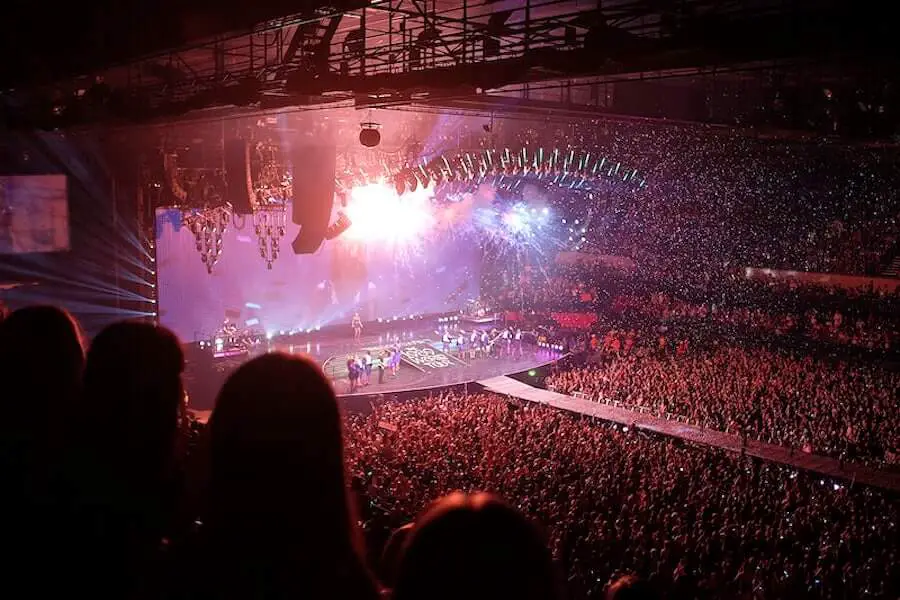How can you take good pictures in the dark? Luckily, digital cameras offer a flash feature to brighten your subject. But this function doesnt always work.
Do you use flash for concert photography? Sadly, the flash may not be the ideal setup for your photos in this case. Lets discuss the issue further in the post!
Table of Contents
Do You Use Flash For Concert Photography?
The flash can still light the scene. However, using flash is not allowed in concerts because it affects the artists and your fellows. The image quality will also be low.
Rudeness
Most venues ban the use of flash photography. Imagine the intense light pointing at you; how can you continue your performance?
Things worsen if ten concert-goers do the same thing. They will destroy the stage for sure.
Your fellows dislike the flash too. The light will blind them, preventing them from enjoying the concert.
Low-quality images
Your smartphones or cameras flash is only helpful when you are close to the subject. It does an excellent job of illuminating subjects five to ten feet away. Yet, the artists on the stage are often much farther.
The flash only brightens the head of the man in front of you. So if you want to actually light up the artists, make sure you are in the front row.
So, we can be certain that using the flash degrades the image you are trying to take. Your favorite performers will be only a dim blur in the background.

How Can You Get Great Concert Photos?
A low-lit environment, like a concert, demands something to light it up.
What to do when you cant use the flash? Dont worry. The following tips will help you take stunning pictures in such conditions.
Use a fast lens
A fast lens has a high maximum aperture, which allows more light to enter and works perfectly in dim lighting.
During a concert, using a larger aperture will enable you to employ a fast shutter speed. You can also use it to freeze motion for improved clarity.
The only drawback of this method is the price tag. However, if you intend to photograph concerts or are very passionate about photography, they are a worthy investment.
If you have a limited budget, choose the 50mm fixed lens instead. It also offers a broad aperture, although it cant zoom in or out smoothly.
Enhance the aperture
Using a fast lens is a good idea, but you may want to ensure the lens is wide open. In this case, take your picture with the lowest aperture, allowing more light to access the camera. The best apertures for concert photography are f2.8 and f1.8.
Use manual exposure mode.
The illumination during a concert might change dramatically throughout the show, which can be challenging to adapt to.
These light effects might take a lot of work to create, but they can also be a photographers biggest nightmare.
If your camera settings are in manual mode, you can control the brightness and exposure more. But how does it happen?
When photographing concerts, your camera settings should respond to your surroundings quickly.
Thankfully, you can customize your settings in advance and make adjustments as you go by using manual mode.

Adjust the ISO
The responsiveness of your camera to illumination depends on its ISO setting.
A higher ISO makes the camera sensor more sensitive to light and swiftly adapts to the light.
A high ISO is essential when shooting in dim light since it will ensure that your photos receive adequate illumination and dont turn out too blurry or dark.
It would be best to start with a 1600 ISO. Then, increase it to a maximum of ISO 3200 to compensate for low light if needed.
Remember that a higher ISO may cause your concert photographs to have more grain and noise. However, a good image with some grain is better than one with fuzzy edges or poor lighting.
Even at higher ISOs, many modern digital cameras capture photographs of exceptional quality.
Moreover, you can minimize the noise in post-production by using noise reduction applications.
Go for a quick shutter speed.
To catch the performers and the audience, you need to move continuously. Additionally, you must reply to stage performers as they walk, sing, or dance.
You can catch motion without getting blurry pictures if your shutter speed is 1/250 or higher. This method helps you capture the crowds and the artists energy while properly freezing the moment on camera.
Depending on the lighting and the performers, you will need to alter the shutter speeds. For example, if the performers are not active, go for a lower shutter speed, and you can still take crisp photos.
Use spot metering
Spot metering is a tool that enables your camera to detect the light reflected from the subjects face instead of the one exposed to stronger light.
This tool is helpful while photographing concerts because you will be shooting artists whose stage is dark except for the spotlight.
Besides, overexposed faces are common problems, especially when the environment is dark and there is a spotlight. Yet, spot metering can solve the problem easily.

Best Camera Gear for Concert Photography
To take concert pictures, photographers frequently use a simple camera and lens set. The digital SLR camera and 500 lenses are among the most common and best choices.
Digital SLR Camera
Shooting concert photos is challenging because you have to react immediately to the shows performers, audience, and mood.
To handle all the situations, you need a high-quality camera. If possible, choose a compact model so you can grab it quickly and shoot the beautiful moments on the go. The digital SLR camera is something like that.
A digital single-lens reflex camera, often known as a DSLR or digital SLR, is a popular type of camera utilized by both amateurs and pros because it gives superior image quality.
With a DSLR camera, you can view the accurate view youre taking in the viewfinder, which improves your skill in visualizing and recording scenes.
This camera offers multiple features, such as shutter speed and light settings. You can adjust them quickly to respond to the concert scenarios.
Although using a manual camera to take film may yield some cool-looking pictures, it can be difficult to capture a variety of images rapidly.
Consider buying a digital SLR camera, like the ones offered by Canon and Nikon, when seeking a kit for concert photography. These models can handle the lenses to shoot brilliant concert shots.

50mm Lens
This lens will be a terrific long-term investment if you often work on concert projects. It can swiftly and effectively capture diverse viewpoints.
Your digital camera will perform well with a 50mm lens because it is a workhorse. Moreover, it is a reasonably priced lens, so beginners dont have to pay too much for their first gear.
Most concert photographers choose a 50mm f1.4 or 50mm f1.8 lens from the same manufacturer as their camera.

Frequently Asked Questions
1. Do professional photographers use flash?
Yes, professional photographers add flash to enhance the intensity and color in their images and give them the impression of dimension and wide-screen sharpness.
Flash also aids in reducing the size of the foreground items since it causes them to look closer and more outline-like than they really are.
Additionally, flash enables photographers to produce dynamic images or motionless scenes that strike out as exceptional.
2. Do you need a flash for indoor photography?
Low-light interior settings are a typical reason to use a flash device. The flash will assist in lighting your subject if there is insufficient ambient light.
Using a flash in a dimly lit room can be beneficial because your camera cannot detect objects that are not reflecting light.
3. How do you take low-light photos at a concert?
When taking concert pictures, you need to pay attention to the light condition and the movement of your subjects. The following tips will help you capture good concert shots even when the light is low:
- Use a fast lens
- Enhance the aperture
- Use manual exposure mode
- Adjust the ISO
- Go for a quick shutter speed
- Use spot metering
Conclusion
Flash is not preferable to use in a concert. However, you can work with your camera lens, aperture, exposure model, ISO, shutter speed, and spot metering to yield an amazing shot.
Hopefully, you will find this article helpful. If you need more photography tips, dont hesitate to contact us. We are always eager to help you.
Thank you for reading, and see you in the next post!

